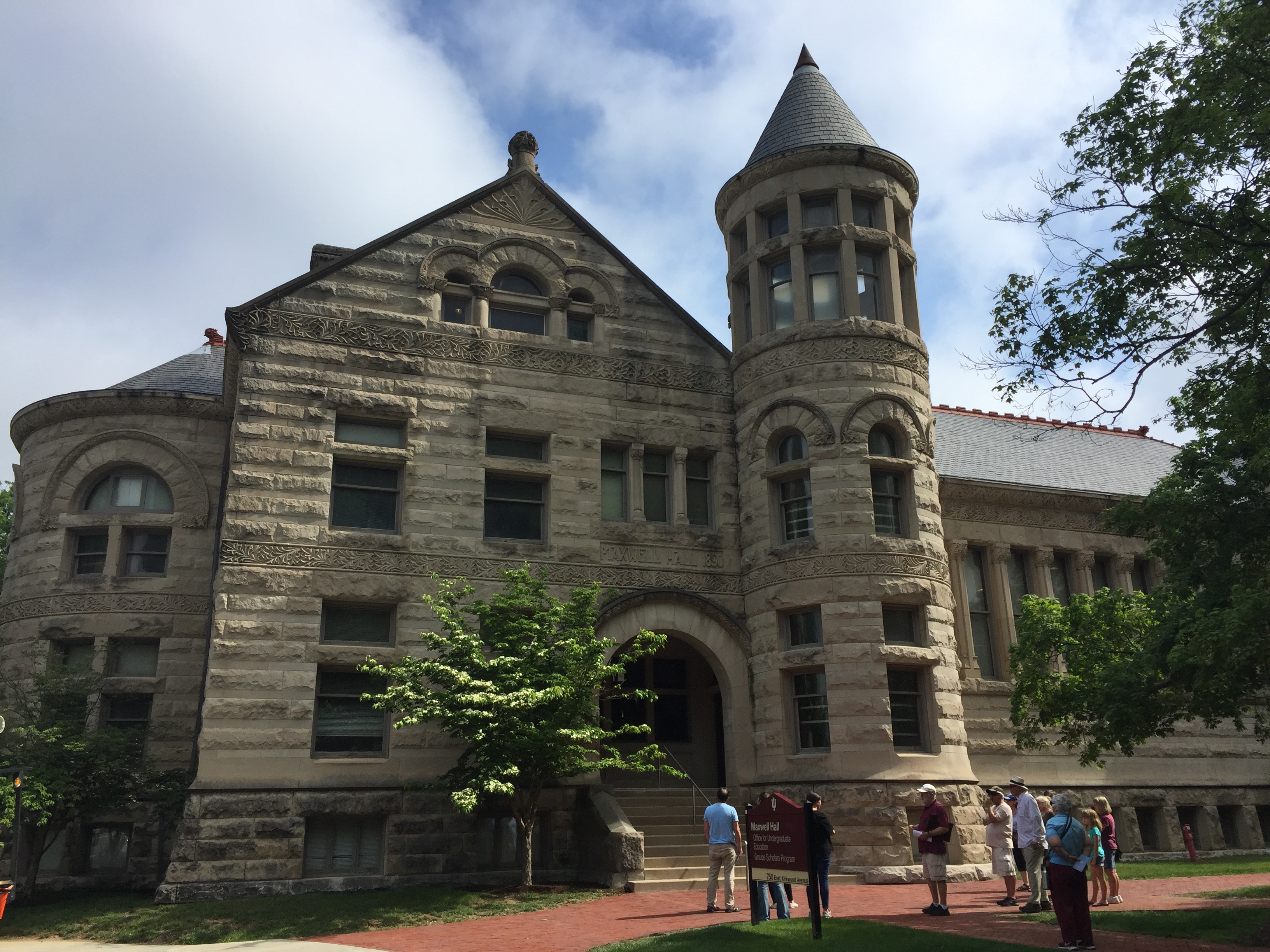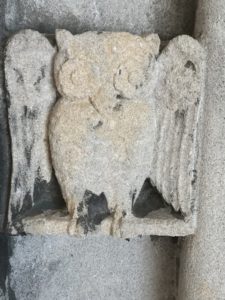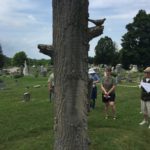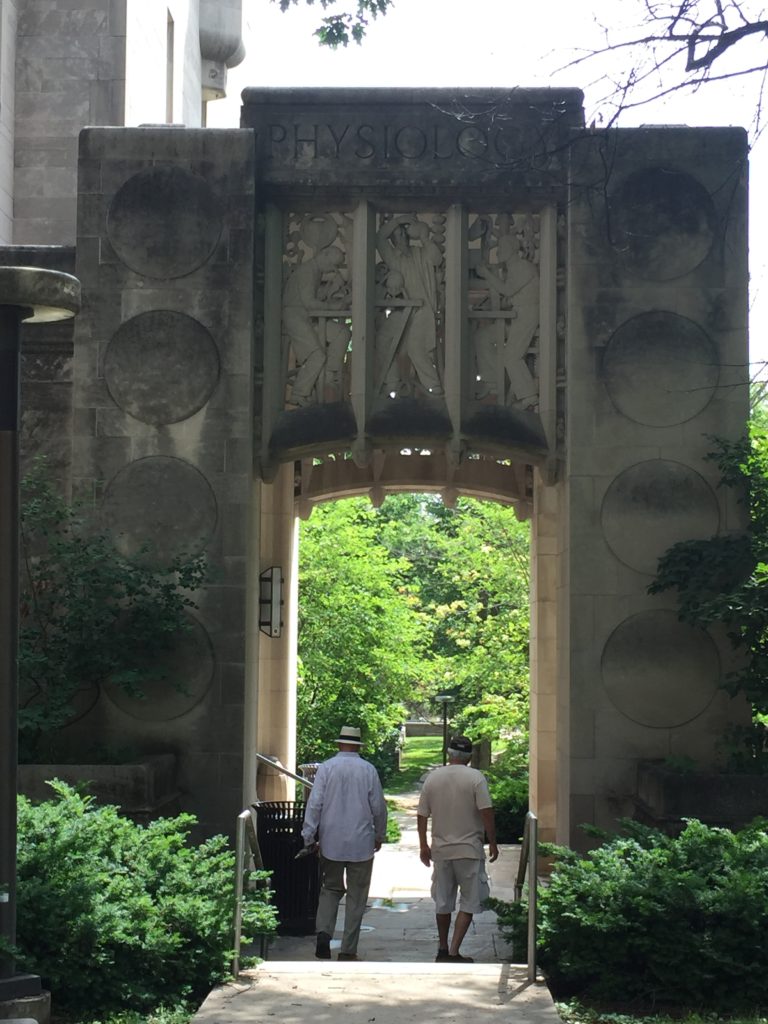
 Bloomington, IN–A stroll through Indiana University’s campus reveals a grand landscape of Collegiate Gothic, Romanesque Revival, and Art Deco limestone buildings. But did you take in the diverse designs of stones and carvings? It’s almost the saying in reverse: not seeing the trees for the forest. Though I spend my four undergraduate years on the IU campus and lived in an historic neighborhood dotted with limestone homes, I never really noticed what made it so quintessentially collegiate. I just felt it.
Bloomington, IN–A stroll through Indiana University’s campus reveals a grand landscape of Collegiate Gothic, Romanesque Revival, and Art Deco limestone buildings. But did you take in the diverse designs of stones and carvings? It’s almost the saying in reverse: not seeing the trees for the forest. Though I spend my four undergraduate years on the IU campus and lived in an historic neighborhood dotted with limestone homes, I never really noticed what made it so quintessentially collegiate. I just felt it.
June is Indiana limestone month, with lots of free walking tours and events like limestone carving classes to enjoy in southern Indiana. I choose three walking tours, two on the IU campus, and learned a lot about what makes this stone so special and unique to the area.
“I’m not an architect or an artist. My passion in geology is limestone,” says Brian Keith, a geologist retired from the Indiana Geological and Water Survey, our campus tour guide. He has 20 years of research in quarries and on campus, and helped prepare a self-guided walking tour for those not lucky enough to come during his walks during limestone month.
For nearly 200 years, Salem Limestone has been mined from Monroe County (where Bloomington is located) south to Lawrence County. Also known as Indiana limestone, huge, thick beds of the medium grained, uniformly colored stone can be carved and sawed, making it ideal for building. New York City’s Empire State Building, Washington, D.C.’s Pentagon and National Cathedral, Chicago’s Tribune Tower, and the Biltmore House in Asheville, North Carolina all use Indiana limestone. Of course, it’s the predominant stone for the Indiana University Bloomington campus and surrounding area, and using walking guides from Visit Bloomington, visitors can learn a little about this bedrock trait of the community.
“IU made a commitment to limestone early on,” Keith tells us. The university still honors that, and only two newer buildings within the core campus are not limestone. Even the two oldest buildings–Owen Hall (1887) and Wylie Hall (1884)– which are made of brick, have thick, hand-quarried limestone foundations. Nearby, the iconic Rose Well House (1908) contains limestone from the original IU campus location about a mile away.
 “There are 12 owls carved into buildings,” Keith says, more than any other creature, though there are lots of IU insignias, gargoyles and grotesques, such as those on Maxwell Hall (1890). Even though limestone is impervious, water will stick to it, resulting in a black color where lichen grows. Other stones have a rusty look that is actually an applied finish using quartz and a steel saw. Keith points out fossils still embedded in the coarse grain surface stones of Rawls Hall (1922). In front of Jordan Hall (1954) a low stone fence lines Third Street. “Scottish itinerant masons built the fence by hand, piece by piece, without mortar,” Keith says. The stones on the top contain sparkling geodes that are buried in one of the limestone layers.
“There are 12 owls carved into buildings,” Keith says, more than any other creature, though there are lots of IU insignias, gargoyles and grotesques, such as those on Maxwell Hall (1890). Even though limestone is impervious, water will stick to it, resulting in a black color where lichen grows. Other stones have a rusty look that is actually an applied finish using quartz and a steel saw. Keith points out fossils still embedded in the coarse grain surface stones of Rawls Hall (1922). In front of Jordan Hall (1954) a low stone fence lines Third Street. “Scottish itinerant masons built the fence by hand, piece by piece, without mortar,” Keith says. The stones on the top contain sparkling geodes that are buried in one of the limestone layers.
Even the new buildings on campus are carefully coordinated with nearby structures. Simon Hall (2007), forming a courtyard with Myers Hall (1936). Sculptor Amy Brier worked with faculty to create a “The Chemistry of Life” a design carved by Indiana Limestone Company artists on the on the conference center entrance. It includes E. coli bacterium, ribonucleic acid, an ear of corn, a fruit fly, a mouse, and paramecium.

Frank E. McKinney Jr. Fountain (1999) in front of the Simon Music Center (1995), with its main spray surrounded by risers of limestone on one side and big limestone blocks on the other, represents a conductor with the orchestra, with an audience in attendance. Kids love splashing in it while adults rest on the audience side.
More history and limestone involves a walk through Rose Hill cemetery, featuring the graves of former IU administrators and quarry owners, as well as other Bloomington notables. Kinsey Sex Research Institute founder Alfred Kinsey and his wife Clara are buried here, though they have granite headstones. Wilbur Carol Bybee’s limestone headstone features carved columns. Bybee’s mill produced stones for the Pentagon restoration after 9/11.
Just south of the IU campus, professors and quarry owners and master carvers built homes in Vinegar Hill. Formerly an apple orchard, the new neighborhood got its name from the rotting fruit. Most of the historic homes on this walking tour can be found along First Street between Woodlawn and Jordan Avenue. Look for gargoyles and carved doorways at master carver Domenick Mazullo’s home at 1002 E. First, beautiful parapeted walls and stone finials at the Tudor Revival Matthews-Temple house at 725 South Highland, and the Spanish Colonial Harry Donato House at 1116 East First. The City of Bloomington offers a self-guided walking tour map of this as well as other neighborhoods.
My tour guide of Vinegar Hill, Rachel Ellenson, City of Bloomington Historic Preservation Program Manager, recalled her days as an undergraduate living in the Domenick Mazullo home. Inside, it featured a limestone fireplace and other carvings. I reminisced living next door to a brick house at 1320 East First when I was a student. Back then, I stopped by to say hello to our nice elderly neighbor lady who was clearing branches that had fallen from the many trees on her property. “Nice to meet you,” she said, and we exchanged pleasantries. Later I learned she was Clara Kinsey.
Whether you’re exploring Bloomington for its history, its architecture, or a just a stroll down memory lane, the tours of limestone month can be a great way to dig deeper.


